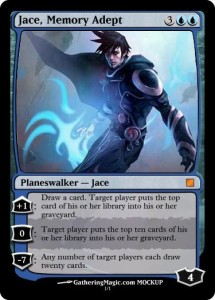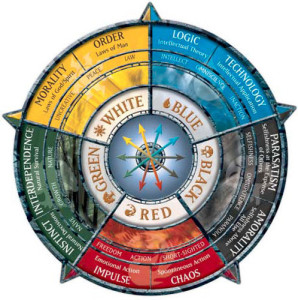(Todays article is brought to you by the 4LN Magic contributor, Jason Hill. Please enjoy.)
The holidays are over and a new year has begun. Along with the new year, comes a new deck to build. With thousands of different cards to choose from, how do you narrow it down to a mere 60 card deck? Should you limit it to only 60? The rules say you can have more if you want. Do you need spend a ton of money on new cards? Are older cards better than the newer ones? How much land should this fun deck have? Is it possible to make a deck that doesn’t suck while at the same time doesn’t make your friends hate you? The answers are: yes, no, maybe, the square root of seven, and the holodeck aboard the S.S. Enterprise. Wait, what were we talking about? … Ah, yes!
First, a disclaimer: This isn’t an article on how to make a deck that will beat all other decks. There are enough of those floating around the internet without my input needing to be added. This article is about making a deck that is fun, not only for you, but your friends as well. Unless, of course, you want to be the kind of person who doesn’t want your friends to have fun. If that’s the case, then stop being a jerk! Nobody likes the person you try to be, no matter what your mother says.
Back to the matter at hand. How to build a fun deck.
Step 1: Figure out what you like. There is a card for almost anything you can imagine. Do you like elves? Knights? Giants? Jellyfish? Unicorns? Ducks? Well too bad! Wizards of the Coast hasn’t made any ducks yet. (Come on, Wizards, what are you waiting for?) If this isn’t helping you figure out what you want, think about your play style. Do you enjoy drawing cards? Do you want to do damage that your opponent can’t block? Do you like to make your opponent discard cards? Maybe not letting your opponent do as they please is your thing. Whatever it is …

Step 2: Pick two or three of these things and start building a deck with them. So you want to have a giants and jellyfish deck that makes your opponent discard cards? Sounds like a fun deck to me. Maybe a cat and elephant deck that has a lot of artifacts in it could be interesting. Just don’t go overboard. A zombie, wizard, ninja, shark, and warrior deck that lets you draw cards, gains you life, counters opponent’s spells, and destroys artifacts might be a bit much. A deck that tries to do too much usually ends up doing nothing at all.
Step 3: Try to narrow your selection down to two or three colors. If you need to go into four colors, don’t fret, but try to stay away from going into all five colors. (tasting the rainbow can be a bit spicy) Five color decks are feasible, but difficult to pull off. The more colors you have, the more types of land you have to include into your deck, resulting in a more difficult time getting the mana required to play your spells.
Step 4: Land ho! Put some land in that deck. Land, being the main mana producer, is incredibly important to balance. It ought to be about a third of your library, meaning anywhere between 18 and 24 cards of your deck. A recommended ratio of spells to land is usually 36 spells : 24 land in a 60 card deck. While this is an excellent mark to build most decks by, each deck is different and that ratio might not suit your selection of spells.

I usually use between 20 and 22 land in most of mine. There are 2 exceptions for me, one for more and one for less. When I use more, (24 – 26) the spells I’m using usually rely on having land as basis for the rules of that particular spell. Example: “Gain 1 life for each land under your control” or “… deals 1 damage for each Mountain you control.” When I use less, (18 or 19) it’s because most of the spells in my library cost less than 3 in their converted mana cost, and I’m able to fit more spells in.
How much of each color is going to depend on the spells you have chosen. If you have kept your spells to one color, then it’s pretty much a no brainer. Just add the number of land you need and start playing. If you have more than one color, a little more work is involved. First separate out your spells by color. If you have 2 colors, try to split your land evenly unless you have mostly 1 color and only a few of the other. If that is the case, use mostly the land of your prominent color with 2 – 5 of the lesser color and maybe one or two multicolor land that share both colors. If you have 3 colors, again try to split the land evenly, but use common sense, and definitely put in a couple of multicolored land or an artifact that can give mana.
If you have more than 3 colors you should rely on multicolored lands fairly heavily along with mana giving artifacts and creatures. This should help keep you from getting the wrong colored mana when trying to cast spells. It sucks having nothing but plains and islands out with a hand full of forest cards. A word of warning though, most multicolored land have to come into the battlefield tapped, so you aren’t able to use them that turn.
Step 5: Keep your deck as close to 60 cards as possible. Yes, I know, the rules say you can have as many as you like over the 60 card minimum, but they advise that you stay as close to the minimum as possible for a reason. The reason is the more cards you have in your deck, the less likely you will come across them in a game. Now if your deck consists of 61, 62, or even 65 cards, no one will come and force you to go to magic kindergarten or exile you and put you in a dungeon in the land you were exiled to. You may relax and have a whimsical time with the deck you have made. If you have something in the realm of 75 or more, then you might want to start making some cuts. If you don’t, it might be real difficult to get out that awesome minotaur you built your deck around.
Step 6: Play with friends. Time to test out your final creation. See which cards you enjoy drawing, and which cards you aren’t so excited to see. Switch out what works with what doesn’t, and remember, this deck is about having fun, not about always winning. Anecdote time!

I remember this one specific moment where my friends and I were having a 4 on 4 free-for-all battle. I was using an earlier incarnation of my Angel deck. I don’t remember what decks they were using, but I do remember that they kept killing my angels. Angels, for the most part, are expensive. So I was only able to get one out per turn, and each time I did, someone else would get rid of it. After my third angel was Doom Bladed, I was frustrated and fed up.
I tapped 4 mana and slapped down the last card in my hand. I said, “Fine! If that’s how it is, then destroy all your creatures!” It was Day of Judgment and the text on the card literally says “Destroy all creatures.” Everyone was flabbergasted. None of them had seen the card before and didn’t realize that all creatures could be destroyed at once like that. The room filled with exclamations of “What the …?!” and “No way!” The card was read by each one in turn and they put all their creatures in their graveyards. I didn’t win that game, but I will always remember the look on their faces.
Now to settle the dispute of which is better, old cards or new cards. The answer is both. New cards are awesome, but don’t dismiss the older cards thinking that they are outdated. The possibilities with combining the old with the new are endless and can have awesome, weird, or just down right hilarious results. Also, good decks don’t have to cost millions, they don’t have to be filled with mythic rares, they just simply need to reflect you and how you define fun.
My goal in building decks is to build a deck that can win, but isn’t one that is to be feared. When I have a deck that is feared, I either find myself the target of everyone playing me (I usually play in group free-for-alls) or not being played against at all. My philosophy is “It’s not whether you win or lose, it’s the memories you make playing.” So play on, and have fun!
(While Jason Hill excels in building fun, casual decks, he fails spectacularly at building fun, casual card houses.)
